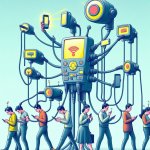In today’s fast-paced digital world, smartphones have become an integral part of our lives. They keep us connected, entertained, and informed. However, as we grow more dependent on these devices, concerns about their impact on our attention span have surfaced. Are smartphones helping us multitask efficiently, or are they rewiring our brains for shorter bursts of focus?

Attention is the brain’s ability to focus on a task while filtering out distractions. Traditionally, humans evolved to concentrate on tasks for extended periods—reading, problem-solving, or deep conversations. However, with smartphones offering instant gratification through notifications, scrolling feeds, and quick dopamine hits, sustained focus is becoming increasingly challenging.
Studies have shown that the average human attention span has decreased, with some researchers claiming it has dropped below that of a goldfish—just 8 seconds. While this comparison is often debated, there’s no denying that smartphones encourage fragmented thinking. Every notification disrupts our cognitive flow, making it harder to engage in deep work or retain information effectively.
Research suggests that multitasking with digital devices impairs productivity. When we shift attention between tasks, the brain takes more time to recalibrate, causing a decline in focus and mental clarity. This phenomenon, known as task-switching cost, reduces work efficiency and contributes to cognitive fatigue.
Many users experience phantom notifications, where they feel their phone vibrate even when no message arrives. This subconscious attachment to digital devices makes it harder to detach from screens, reducing our ability to engage in prolonged focus.

The Science Behind Attention & Distraction
Attention is the brain’s ability to focus on a task while filtering out distractions. Traditionally, humans evolved to concentrate on tasks for extended periods—reading, problem-solving, or deep conversations. However, with smartphones offering instant gratification through notifications, scrolling feeds, and quick dopamine hits, sustained focus is becoming increasingly challenging.
Studies have shown that the average human attention span has decreased, with some researchers claiming it has dropped below that of a goldfish—just 8 seconds. While this comparison is often debated, there’s no denying that smartphones encourage fragmented thinking. Every notification disrupts our cognitive flow, making it harder to engage in deep work or retain information effectively.
The Rise of Digital Multitasking
Smartphones offer instant access to multiple streams of content, from social media to emails, news, and entertainment. While this may seem like an advantage, it often leads to excessive multitasking. Rather than completing one task at a time, users constantly switch between apps and activities, leading to reduced cognitive efficiency.Research suggests that multitasking with digital devices impairs productivity. When we shift attention between tasks, the brain takes more time to recalibrate, causing a decline in focus and mental clarity. This phenomenon, known as task-switching cost, reduces work efficiency and contributes to cognitive fatigue.
Social Media & Instant Gratification
Social media platforms are designed to keep users engaged for as long as possible. The endless scroll, quick dopamine hits from likes and comments, and autoplay features make it difficult to disengage. This reinforces short-term gratification over long-term concentration, affecting our ability to read lengthy articles or complete complex projects without distractions.Many users experience phantom notifications, where they feel their phone vibrate even when no message arrives. This subconscious attachment to digital devices makes it harder to detach from screens, reducing our ability to engage in prolonged focus.
How to Reclaim Attention in a Smartphone Era?
While smartphones offer undeniable benefits, maintaining attention requires conscious effort. Here are some strategies to combat digital distraction:- Turn Off Unnecessary Notifications: Minimize disruptions by selectively enabling essential alerts.
- Use Focus Modes: Apps and settings like "Do Not Disturb" help create distraction-free periods.
- Practice Deep Work: Dedicate time for uninterrupted work, avoiding multitasking.
- Limit Screen Time: Set boundaries for social media and entertainment apps.
- Engage in Offline Activities: Reading books, journaling, or outdoor activities improve attention span naturally.
